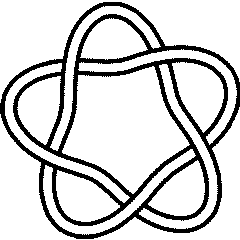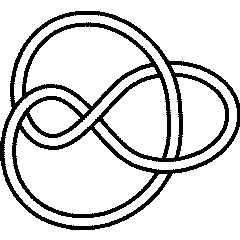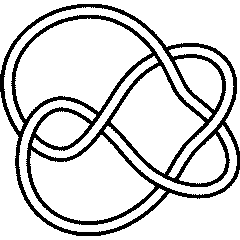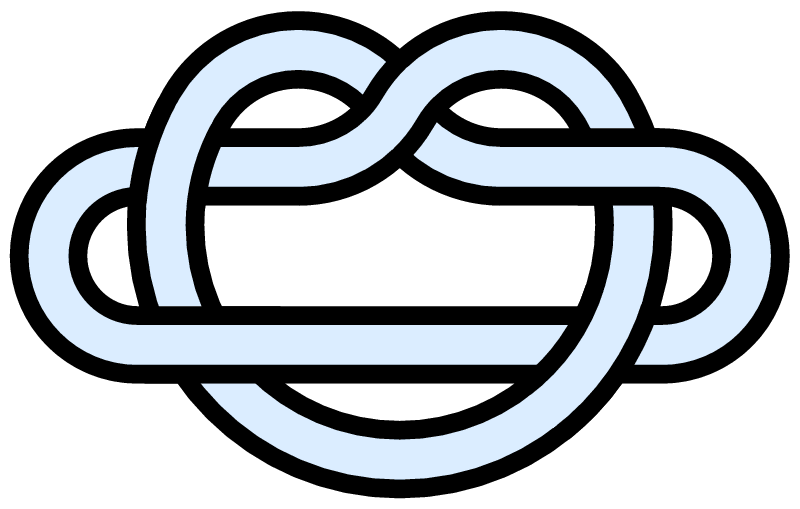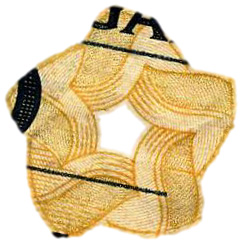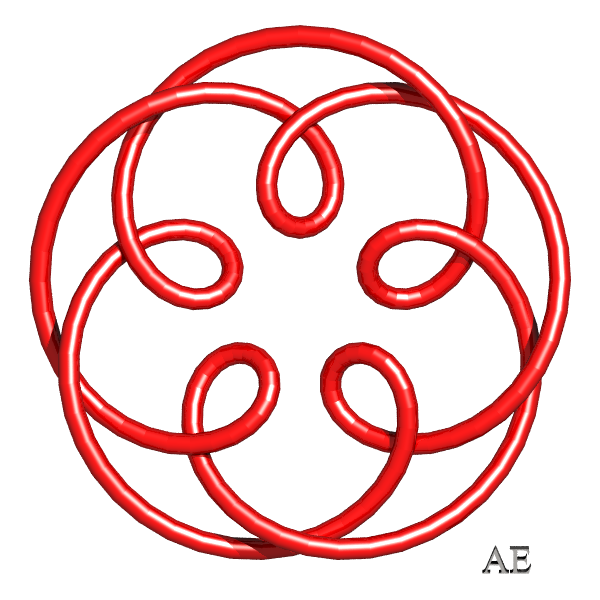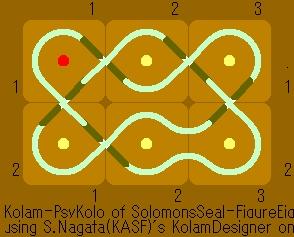 A kolam of a 2x3 dot array |
 The VISA Interlink Logo [1] |
|
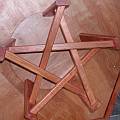 A pentagonal table by Bob Mackay [2] |
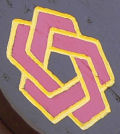 The Utah State Parks logo |
 As impossible object ("Penrose" pentagram) |
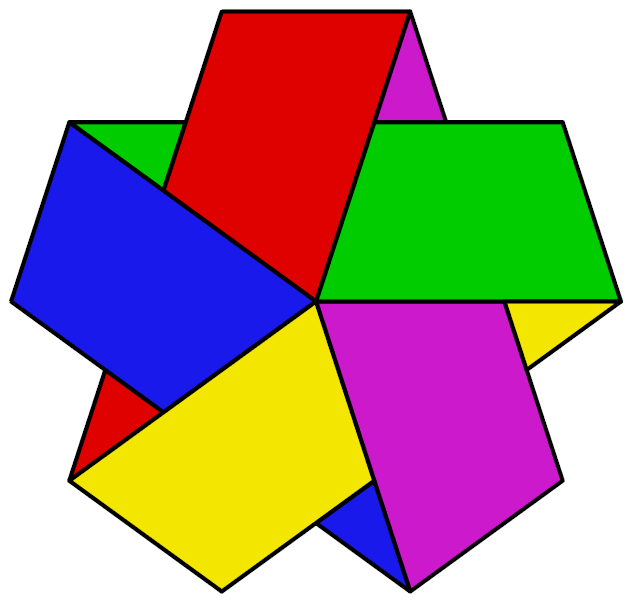 Folded ribbon which is single-sided (more complex version of Möbius Strip). |
|
|
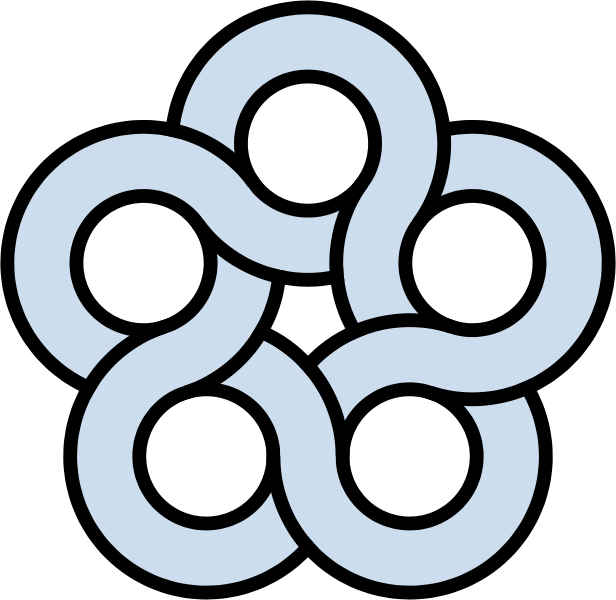 Alternate pentagram of intersecting circles. |
|
 Partial view of US bicentennial logo on a shirt seen in Lisboa [3] |
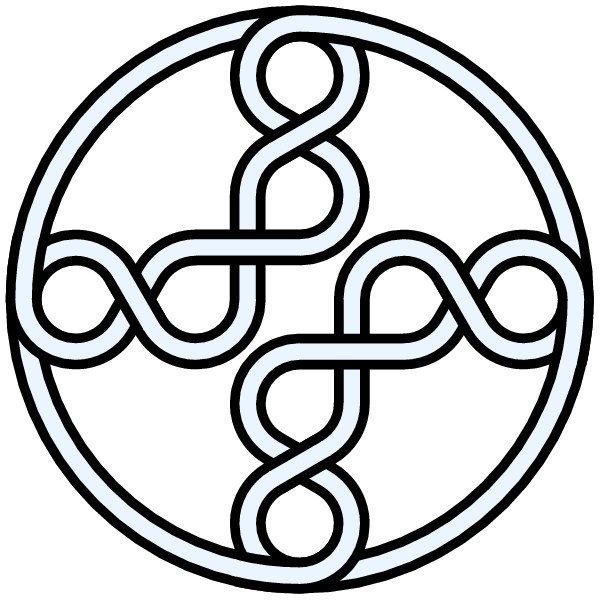 Non-prime knot with two 5_1 configurations on a closed loop. |
|
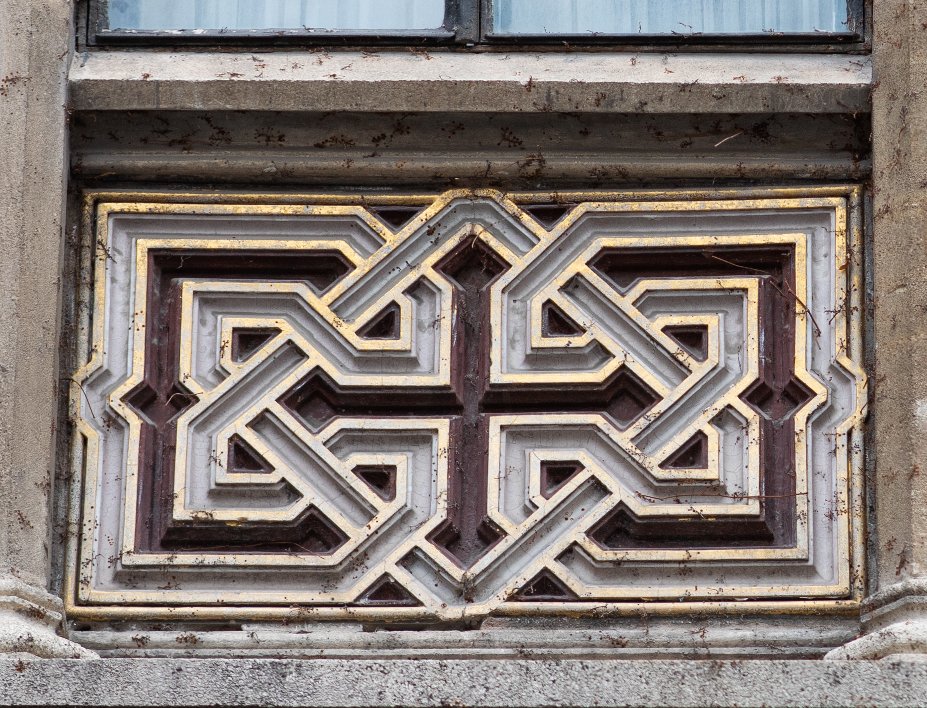 Sum of two 5_1s, Vienna, orthodox church |
This sentence was last edited by Dror.
Sometime later, Scott added this sentence.
Knot presentations
| Planar diagram presentation
|
X1627 X3849 X5,10,6,1 X7283 X9,4,10,5
|
| Gauss code
|
-1, 4, -2, 5, -3, 1, -4, 2, -5, 3
|
| Dowker-Thistlethwaite code
|
6 8 10 2 4
|
| Conway Notation
|
[5]
|
Four dimensional invariants
Polynomial invariants
| Alexander polynomial |
 |
| Conway polynomial |
 |
| 2nd Alexander ideal (db, data sources) |
 |
| Determinant and Signature |
{ 5, -4 } |
| Jones polynomial |
 |
| HOMFLY-PT polynomial (db, data sources) |
 |
| Kauffman polynomial (db, data sources) |
 |
| The A2 invariant |
 |
| The G2 invariant |
 |
Further Quantum Invariants
Further quantum knot invariants for 5_1.
A1 Invariants.
| Weight
|
Invariant
|
| 1
|

|
| 2
|

|
| 3
|

|
| 4
|

|
| 5
|

|
| 6
|

|
| 8
|

|
A2 Invariants.
| Weight
|
Invariant
|
| 1,0
|

|
| 1,1
|

|
| 2,0
|

|
| 3,0
|

|
A3 Invariants.
| Weight
|
Invariant
|
| 0,1,0
|

|
| 1,0,0
|

|
| 1,0,1
|

|
A4 Invariants.
| Weight
|
Invariant
|
| 0,1,0,0
|

|
| 1,0,0,0
|

|
B2 Invariants.
| Weight
|
Invariant
|
| 0,1
|

|
| 1,0
|

|
B3 Invariants.
| Weight
|
Invariant
|
| 1,0,0
|

|
B4 Invariants.
| Weight
|
Invariant
|
| 1,0,0,0
|

|
C3 Invariants.
| Weight
|
Invariant
|
| 1,0,0
|

|
C4 Invariants.
| Weight
|
Invariant
|
| 1,0,0,0
|

|
D4 Invariants.
| Weight
|
Invariant
|
| 0,1,0,0
|

|
| 1,0,0,0
|

|
G2 Invariants.
| Weight
|
Invariant
|
| 0,1
|

|
| 1,0
|

|
.
Computer Talk
The above data is available with the
Mathematica package
KnotTheory`, as shown in the (simulated) Mathematica session below. Your input (in
red) is realistic; all else should have the same content as in a real mathematica session, but with different formatting. This Mathematica session is also available (albeit only for the knot
5_2) as the notebook
PolynomialInvariantsSession.nb.
(The path below may be different on your system, and possibly also the KnotTheory` date)
In[1]:=
|
AppendTo[$Path, "C:/drorbn/projects/KAtlas/"];
<< KnotTheory`
|
|
|
KnotTheory::loading: Loading precomputed data in PD4Knots`.
|
Out[4]=
|

|
Out[5]=
|

|
In[6]:=
|
Alexander[K, 2][t]
|
|
|
KnotTheory::credits: The program Alexander[K, r] to compute Alexander ideals was written by Jana Archibald at the University of Toronto in the summer of 2005.
|
Out[6]=
|

|
In[7]:=
|
{KnotDet[K], KnotSignature[K]}
|
|
|
KnotTheory::loading: Loading precomputed data in Jones4Knots`.
|
Out[8]=
|

|
In[9]:=
|
HOMFLYPT[K][a, z]
|
|
|
KnotTheory::credits: The HOMFLYPT program was written by Scott Morrison.
|
Out[9]=
|

|
In[10]:=
|
Kauffman[K][a, z]
|
|
|
KnotTheory::loading: Loading precomputed data in Kauffman4Knots`.
|
Out[10]=
|

|
| V2,1 through V6,9:
|
| V2,1
|
V3,1
|
V4,1
|
V4,2
|
V4,3
|
V5,1
|
V5,2
|
V5,3
|
V5,4
|
V6,1
|
V6,2
|
V6,3
|
V6,4
|
V6,5
|
V6,6
|
V6,7
|
V6,8
|
V6,9
|

|

|

|

|

|

|

|

|

|

|

|

|

|

|

|

|

|

|
|
V2,1 through V6,9 were provided by Petr Dunin-Barkowski <barkovs@itep.ru>, Andrey Smirnov <asmirnov@itep.ru>, and Alexei Sleptsov <sleptsov@itep.ru> and uploaded on October 2010 by User:Drorbn. Note that they are normalized differently than V2 and V3.
The coefficients of the monomials  are shown, along with their alternating sums are shown, along with their alternating sums  (fixed (fixed  , alternation over , alternation over  ). The squares with yellow highlighting are those on the "critical diagonals", where ). The squares with yellow highlighting are those on the "critical diagonals", where  or or  , where , where  -4 is the signature of 5 1. Nonzero entries off the critical diagonals (if any exist) are highlighted in red. -4 is the signature of 5 1. Nonzero entries off the critical diagonals (if any exist) are highlighted in red.
|
|
|
-5 | -4 | -3 | -2 | -1 | 0 | χ |
| -3 | | | | | | 1 | 1 |
| -5 | | | | | | 1 | 1 |
| -7 | | | | 1 | | | 1 |
| -9 | | | | | | | 0 |
| -11 | | 1 | 1 | | | | 0 |
| -13 | | | | | | | 0 |
| -15 | 1 | | | | | | -1 |
|
Computer Talk
Much of the above data can be recomputed by Mathematica using the package KnotTheory`. See A Sample KnotTheory` Session.

In[1]:= |
<< KnotTheory` |
Loading KnotTheory` (version of August 17, 2005, 14:44:34)... |
In[2]:= | Crossings[Knot[5, 1]] |
Out[2]= | 5 |
In[3]:= | PD[Knot[5, 1]] |
Out[3]= | PD[X[1, 6, 2, 7], X[3, 8, 4, 9], X[5, 10, 6, 1], X[7, 2, 8, 3],
X[9, 4, 10, 5]] |
In[4]:= | GaussCode[Knot[5, 1]] |
Out[4]= | GaussCode[-1, 4, -2, 5, -3, 1, -4, 2, -5, 3] |
In[5]:= | BR[Knot[5, 1]] |
Out[5]= | BR[2, {-1, -1, -1, -1, -1}] |
In[6]:= | alex = Alexander[Knot[5, 1]][t] |
Out[6]= | -2 1 2
1 + t - - - t + t
t |
In[7]:= | Conway[Knot[5, 1]][z] |
Out[7]= | 2 4
1 + 3 z + z |
In[8]:= | Select[AllKnots[], (alex === Alexander[#][t])&] |
Out[8]= | {Knot[5, 1], Knot[10, 132]} |
In[9]:= | {KnotDet[Knot[5, 1]], KnotSignature[Knot[5, 1]]} |
Out[9]= | {5, -4} |
In[10]:= | J=Jones[Knot[5, 1]][q] |
Out[10]= | -7 -6 -5 -4 -2
-q + q - q + q + q |
In[11]:= | Select[AllKnots[], (J === Jones[#][q] || (J /. q-> 1/q) === Jones[#][q])&] |
Out[11]= | {Knot[5, 1], Knot[10, 132]} |
In[12]:= | A2Invariant[Knot[5, 1]][q] |
Out[12]= | -22 -20 -18 -14 -12 2 -8 -6
-q - q - q + q + q + --- + q + q
10
q |
In[13]:= | Kauffman[Knot[5, 1]][a, z] |
Out[13]= | 4 6 5 7 9 4 2 6 2 8 2
3 a + 2 a - 2 a z - a z + a z - 4 a z - 3 a z + a z +
5 3 7 3 4 4 6 4
a z + a z + a z + a z |
In[14]:= | {Vassiliev[2][Knot[5, 1]], Vassiliev[3][Knot[5, 1]]} |
Out[14]= | {0, -5} |
In[15]:= | Kh[Knot[5, 1]][q, t] |
Out[15]= | -5 -3 1 1 1 1
q + q + ------ + ------ + ------ + -----
15 5 11 4 11 3 7 2
q t q t q t q t |
